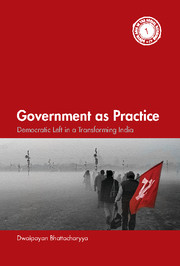Book contents
Appendix I - The Left through Elections
Published online by Cambridge University Press: 05 March 2016
Summary
This section looks at the Left Front in West Bengal through five successive elections – the Lok Sabha (LS) or the national parliament in 2004 and 2009 and the Vidhan Sabha (VS) or the state legislature in 2001, 2006 and 2011 – during the last decade of its governance. While the elections of 2001, 2004 and 2006 reflected the left's undisputable dominance in the state, in 2009 the left received its first serious challenge from a buoyant Trinamul Congress–Congress alliance, which eventually unseated it from power in 2011. Here, we trace the left's transformation from a seemingly invincible political force to the one defeated by focusing on the changing dynamics of its electoral constituency.
In the pages below we attempt to find answers to the following questions: Who voted for the left? What constituted the left's electoral base in West Bengal in terms of economic classes, social categories, age groups or locations? Had there been any significant change in these characteristics over the last decade of the Left Front in power? What did the left's changing electoral fortune actually signify in terms of its broader political effects or its capacity to represent the poor and the marginal? In what way was the left's governmental performance responsible for its electoral decline? What can we make of the social outlook of the left voters? Is it markedly different from the rest?
In taking up these questions, we make use of the massive pre- and post-poll surveys conducted in the course of the National Election Survey (NES) by Lokniti, a group of political and social scientists attached to various academic institutions in India who have done an exemplary work since the mid-1990s of studying voters' identities and opinions in the course of periodic elections at both state and national levels. The surveys are based on significantly large data sets developed from scientific sampling techniques and structured questionnaires, carried out by a dedicated crop of coordinators and investigators spread in every district of the country. In terms of its meticulous planning, time-bound execution, and comprehensive coverage, the NES has no parallel in India. Here, we use fragments of such data collected in West Bengal in the course of 2001 VS, 2004 LS, 2006 VS, 2009 LS and, finally, 2011 VS.
- Type
- Chapter
- Information
- Government as PracticeDemocratic Left in a Transforming India, pp. 213 - 231Publisher: Cambridge University PressPrint publication year: 2016



